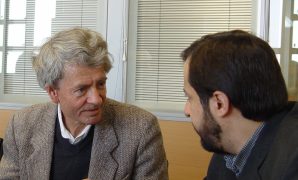میراث مکتوب- تاریخ آغازین متن قرآن یکی از حوزههایی است که در دهههای اخیر شاهد پیشرفتهای چشمگیری بوده، هرچند تنها تعدادی محدود از نسخ بسیار قدیمی قرآن، یا اجزای قابل توجه آن تا به امروز بر جای مانده است. یکی از این نمونهها مصحفی است که بخش اعظم آن در دو نسخۀ محفوظ در کتابخانۀ حرم مقدس در مشهد باقی مانده است. تاریخگذاری کربنی نشان میدهد که احتمالاً این کتاب به نیمۀ دوم قرن اول هجری متعلق است و بررسیهای کهنخطشناسانه نیز این تاریخگذاری را تأیید میکند. متن این مصحف عمدتاً با آن شکل متعارف از قرآن انطباق دارد که بر اساس منابع ما به مدینه منتسب است، اما گاه نیز با قرائتهایی که به مناطق دیگر مربوط است همخوانی دارد. به عکس، تقسیمبندی متن در قالب آیات تفاوت چشمگیری با سنتهای منطقهای مختلف و مشهور دارد. و شگفت آنکه در سه نقطه، این مصحف ظاهراً قرائتهایی را حفظ کرده است که از قرائت مطابق با متن معیار که به قولی حجاج (متوفی ۹۵ هجری) فرماندار وقت عراق تثبیت کرده بود، قدیمیتر است. به این دلایل و به دلایل دیگر، فراهمسازی دسترسی پژوهشگران به چنین مصحفی، خود خدمتی ارزشمند به مطالعۀ تاریخ قرآن است.
اما ویژگی این مصحف فقط قدمتش نیست، بلکه نکات فراوانی دارد که کنجکاوی ما را برمیانگیزد. مصحف مشهد رضوی مثل تقریباً تمام نمونههایی که از قرآن نخستین در اختیار داریم، متن را کمابیش به شکل رسمی و یکنواخت شدهاش در نیمۀ دوم قرن اول هجری حفظ کرده است، و سورهها نیز در آن به شکل متعارف ترتیب یافتهاند. با این حال، مطالعۀ دقیق کریمینیا بیتردید نشان میدهد که در مقطعی پس از نگارش اولیۀ مصحف، ترتیب سورهها به شکل اساسی و با بریدن و چسباندن تغییر یافته است. در اصل سورهها ترتیب کاملاً متفاوتی داشتهاند، و این همان ترتیبی بوده است که بر اساس منابع، میدانیم نسخهای از متن قرآن ـــ که دیگر در اختیار نداریم ـــ پیش از یکنواختسازی چنین ترتیبی داشته است. این نکته به معمای دیگری میانجامد: این نسخۀ مفقود با شهر کوفه در عراق (و عبدالله بن مسعود) مرتبط است، حال آنکه متنی که معیار نگارش مصحف مشهد رضوی بوده است منتسب به مدینه است. اینکه چه شرایطی دست به دست هم داده تا این متن چندسرشت عجیب و تاحدی منحصربهفرد پدید آمده، پرسشی سخت جذاب است. پاسخ هر چه باشد، این مصحف مدرکی مهم است درباب تاریخ مکتوم ارتباط متن معیار قرآن با نسخههایی که پیش از آن رواج داشت.
متن اصلی یادداشت مایکل کوک دربارۀ مصحف مشهد رضوی چنین است:
Codex Mashhad
Michael Cook
Princeton University
The early history of the Qurʾānic text is a field that has seen striking progress in recent decades, despite the fact that only a limited number of really early copies of the Qurʾān, or substantial parts of it, survive today. One of them is a codex large parts of which are found in two manuscripts preserved in the library of the sanctuary in Mashhad. Radio-carbon dating indicates that this codex could be from as early as the second half of the first/seventh century, and palaeographical study supports such a dating. The text is largely identical with the form of the standard text that our sources associate with Medina, but occasionally it agrees instead with readings tied to other regions. By contrast, the division of the text into verses diverges from those of all the various regional traditions known to us. Surprisingly, at three points the codex appears to preserve older readings where those of the standard text were on one account introduced by Ḥajjāj (d. ۹۵/۷۱۴), the governor of Iraq. For all these reasons and more, making such a codex available to scholars is in itself a valuable service to the study of the history of the Qurʾān.
But this codex is not just early, it is also very intriguing. Like almost all our witnesses to the early Qurʾān, it contains the text more or less as standardized in the mid-seventh century, and with the Sūras in the standard order. Yet Karimi-Nia’s careful study shows beyond doubt that the order of the Sūras was reworked at some point in the later history of the codex by a drastic process of cutting and pasting. Originally the Sūras were in a quite different order, one identical with that described in our sources for a version of the text that we no longer possess, but know to have antedated the standardization. This leads to yet another puzzle: this lost version was associated with the city of Kūfa (and Ibn Masʿūd) in Iraq, whereas the version of the standard text behind the Codex Mashhad is Medinese. Just what circumstances gave rise to this strange hybrid — almost though not quite unique — is a fascinating question. Whatever the answer, this codex is a key exhibit in the little-known history of the relationship between the standard text and those it replaced.
مایکل کوک
منبع: حلقه کاتبان – مایسطرون

